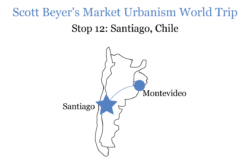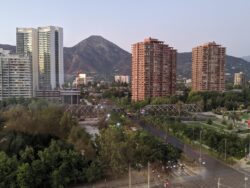Where Free Markets Bring Modernity
What Other Latin American Countries Can Learn From Chile
This column is part of a Catalyst series that chronicles my 1.5-year tour of the Global South. One point of the trip is to better grasp where the “economic future” is, by viewing developing countries that have made lots of progress.
Chile was the 10th country on my tour—and unlike any other in Latin America. The capital, Santiago, was much different from other big cities in South America like Sao Paulo or Buenos Aires. It feels modern and cosmopolitan, more like a forward-looking U.S. city such as Miami. Compared to other cities in the region, it was cleaner, had better amenities, and was clearly wealthier. The same can be said for Chile at large, and it’s worth exploring the market-oriented policy framework that caused this.

Santiago did in fact feel like a boomtown, having added 1 million people the last two decades, and I saw more high-rise construction there than anywhere else in LatAm. I visited the working-class Florida borough and saw single family housing being demolished for towers. I saw this same trend—but more upscale—in Barrio Suecia. That’s where Gran Torre Santiago, the largest skyscraper in South America, is located. The 62-story building was designed by César Pelli, who later designed San Francisco’s Salesforce Tower using a similar design.
The tower is part of the Costanera Center, a large shopping complex. Within the mall you can find lots of U.S. branded stores, like Nike and Forever 21. Compared to other cities I visited, I saw more standardized big box retailers in Chile.
Move further east to Las Condes, and you find perhaps the ultimate Chilean neighborhood. Its mix of glossy towers, high-end restaurants and majestic Araucano Park exceeds most any U.S. neighborhood, and has among LatAm’s highest real estate prices.
Santiago had a modern subway system and quality roads. Chile was among the only LatAm nations I visited with clean tap water. After months of traversing the graffiti and informal slums of neighboring countries, it was refreshing to find little of this in Santiago.
Another city I visited, Valpairoso, wasn’t quite as nice, but had similar amenities and modernization, catering to international artists.

What makes Chile different? Their support for free markets and property rights. The Heritage Foundation’s Index of Economic Freedom ranks it #22—higher than any LatAm country, and even higher than the U.S. Brazil is down at 127, Argentina at 144.
The Heritage Foundation highlights Chile’s “transparent business climate” as a reason for its high ranking. People can easily start businesses when rules are clear, regulations are efficient, and the government protects property rights. Much of Latin America is stereotyped as having corrupt governments, but Heritage says Chile’s government integrity is above the world average.
Chile isn’t just economically free either. The Fraser Institute’s Human Freedom Index ranks it high in personal freedom. People there enjoy freedom of speech, the press, and religion. Same-sex marriage is legal. It’s also a very safe country, with the lowest homicide rate in South America.
It wasn’t always this way. Like other LatAm countries, Chile once experimented with socialism. Marxist Salvador Allende was elected president in 1970. It was a disaster. He nationalized the copper industry, which was Chile’s main business at the time. He increased wages and to pay for that, printed money. That caused inflation to reach 500% by 1973. The government instituted price controls, which led to shortages of basic goods like milk and flour.
In 1973, the military overthrew Allende, and General Augusto Pinochet took power. Pincochet was a dictator; his regime infamously threw socialists and political opponents out of helicopters. Since the military junta did not know much about running a country, a group of Chilean economists who had studied under Milton Friedman at the University of Chicago rose to power. Pinochet appointed them to positions in the government.
The “Chicago boys” implemented free market economic reforms. To fight inflation, they cut social spending and abolished price controls, and privatized 95% of public companies (the copper industry remained nationalized). Allende’s government was skeptical of foreign investment, but the new government embraced free trade and got rid of protectionist barriers. It was a success. Inflation fell below 10% by the 1990s. Per capita incomes quadrupled between 1975 and 2015; today they are about $25,000, edging out Panama for the highest in LatAm (Panama is, as we profiled in February, also a liberalization success story). Chile’s poverty rate fell from 45% in the 1980s to 8% in 2014.
The dictatorship lost power in 1990. Even though Friedman and the Chicago boys are often smeared for aiding a dictatorship, he thought free markets are what led to its end.
“In the end the central government, the military junta, was replaced by a democratic society,” Friedman told a PBS interviewer. “So the really important thing about the Chilean business is that free markets did work their way in bringing about a free society.”
Despite Chile’s free market success, income inequality remains high. In 2019, the government raised subway fares by 4 cents. That sparked massive protests. People demanded changes to address the rising cost of living and wanted higher wages.
Leftist Gabriel Boric was elected president in 2021. Boric promised he would “bury” the free market model left by Pinochet’s dictatorship. He advocates taxes on the super rich and more social services, and says he’ll fight inequality.
It’s unlikely that Chile will slide back into socialism to the level of Cuba or Venezuela. But people in Chile should remember that socialism drove them to poverty and free markets got them out of it, and this is overwhelmingly reflected in the society they now enjoy.
All images credited to Scott Beyer and The Market Urbanist.
Catalyst articles by Scott Beyer | Full Biography and Publications
